Change Management Strategies and Their Impact on the Stakeholders: A Case Study of Pemancar
VerifiedAdded on 2022/11/23
|14
|4296
|397
AI Summary
This paper analyzes the process of merger and acquisition and its related aspects through the usage of the case study of the acquisition of Pemancar by NOVA Europe International Corporation. It highlights the diverse facets of the business operations of the enterprise Pemancar and also the manner in which they had been used to managing the affairs of their business over the years which in turn had enabled it to become a profitable business in the nation of Malaysia.
Contribute Materials
Your contribution can guide someone’s learning journey. Share your
documents today.
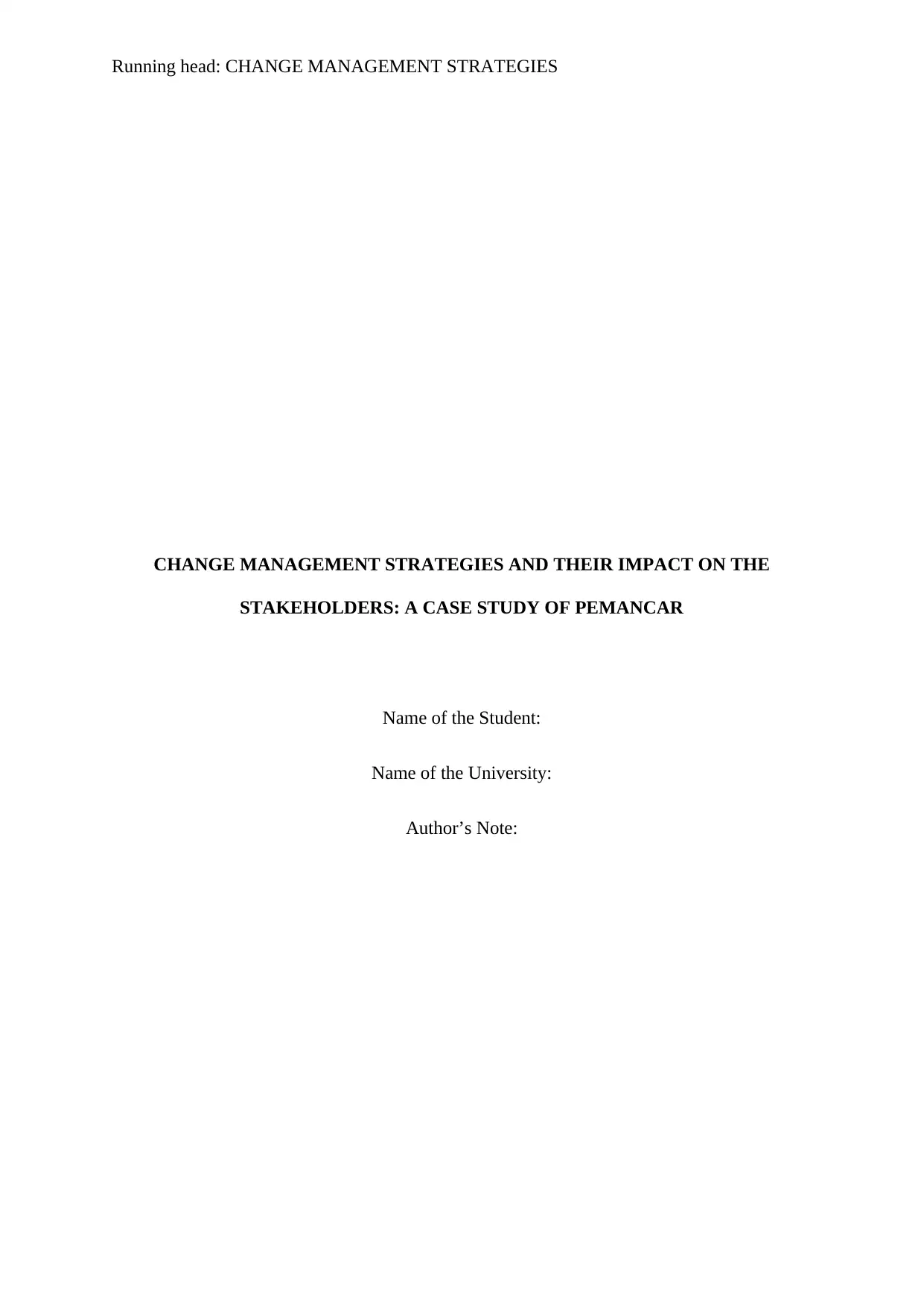
Running head: CHANGE MANAGEMENT STRATEGIES
CHANGE MANAGEMENT STRATEGIES AND THEIR IMPACT ON THE
STAKEHOLDERS: A CASE STUDY OF PEMANCAR
Name of the Student:
Name of the University:
Author’s Note:
CHANGE MANAGEMENT STRATEGIES AND THEIR IMPACT ON THE
STAKEHOLDERS: A CASE STUDY OF PEMANCAR
Name of the Student:
Name of the University:
Author’s Note:
Secure Best Marks with AI Grader
Need help grading? Try our AI Grader for instant feedback on your assignments.
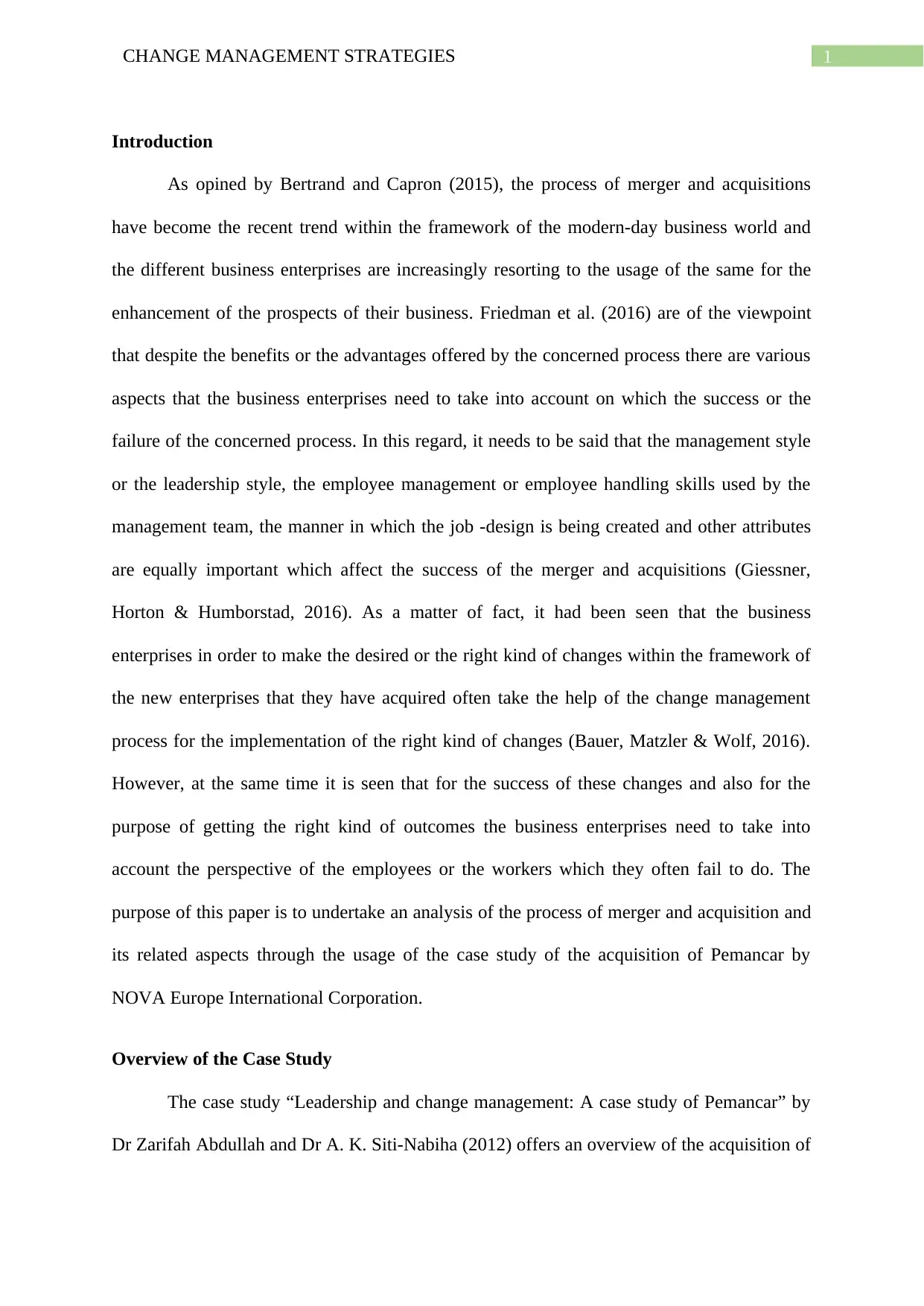
1CHANGE MANAGEMENT STRATEGIES
Introduction
As opined by Bertrand and Capron (2015), the process of merger and acquisitions
have become the recent trend within the framework of the modern-day business world and
the different business enterprises are increasingly resorting to the usage of the same for the
enhancement of the prospects of their business. Friedman et al. (2016) are of the viewpoint
that despite the benefits or the advantages offered by the concerned process there are various
aspects that the business enterprises need to take into account on which the success or the
failure of the concerned process. In this regard, it needs to be said that the management style
or the leadership style, the employee management or employee handling skills used by the
management team, the manner in which the job -design is being created and other attributes
are equally important which affect the success of the merger and acquisitions (Giessner,
Horton & Humborstad, 2016). As a matter of fact, it had been seen that the business
enterprises in order to make the desired or the right kind of changes within the framework of
the new enterprises that they have acquired often take the help of the change management
process for the implementation of the right kind of changes (Bauer, Matzler & Wolf, 2016).
However, at the same time it is seen that for the success of these changes and also for the
purpose of getting the right kind of outcomes the business enterprises need to take into
account the perspective of the employees or the workers which they often fail to do. The
purpose of this paper is to undertake an analysis of the process of merger and acquisition and
its related aspects through the usage of the case study of the acquisition of Pemancar by
NOVA Europe International Corporation.
Overview of the Case Study
The case study “Leadership and change management: A case study of Pemancar” by
Dr Zarifah Abdullah and Dr A. K. Siti-Nabiha (2012) offers an overview of the acquisition of
Introduction
As opined by Bertrand and Capron (2015), the process of merger and acquisitions
have become the recent trend within the framework of the modern-day business world and
the different business enterprises are increasingly resorting to the usage of the same for the
enhancement of the prospects of their business. Friedman et al. (2016) are of the viewpoint
that despite the benefits or the advantages offered by the concerned process there are various
aspects that the business enterprises need to take into account on which the success or the
failure of the concerned process. In this regard, it needs to be said that the management style
or the leadership style, the employee management or employee handling skills used by the
management team, the manner in which the job -design is being created and other attributes
are equally important which affect the success of the merger and acquisitions (Giessner,
Horton & Humborstad, 2016). As a matter of fact, it had been seen that the business
enterprises in order to make the desired or the right kind of changes within the framework of
the new enterprises that they have acquired often take the help of the change management
process for the implementation of the right kind of changes (Bauer, Matzler & Wolf, 2016).
However, at the same time it is seen that for the success of these changes and also for the
purpose of getting the right kind of outcomes the business enterprises need to take into
account the perspective of the employees or the workers which they often fail to do. The
purpose of this paper is to undertake an analysis of the process of merger and acquisition and
its related aspects through the usage of the case study of the acquisition of Pemancar by
NOVA Europe International Corporation.
Overview of the Case Study
The case study “Leadership and change management: A case study of Pemancar” by
Dr Zarifah Abdullah and Dr A. K. Siti-Nabiha (2012) offers an overview of the acquisition of
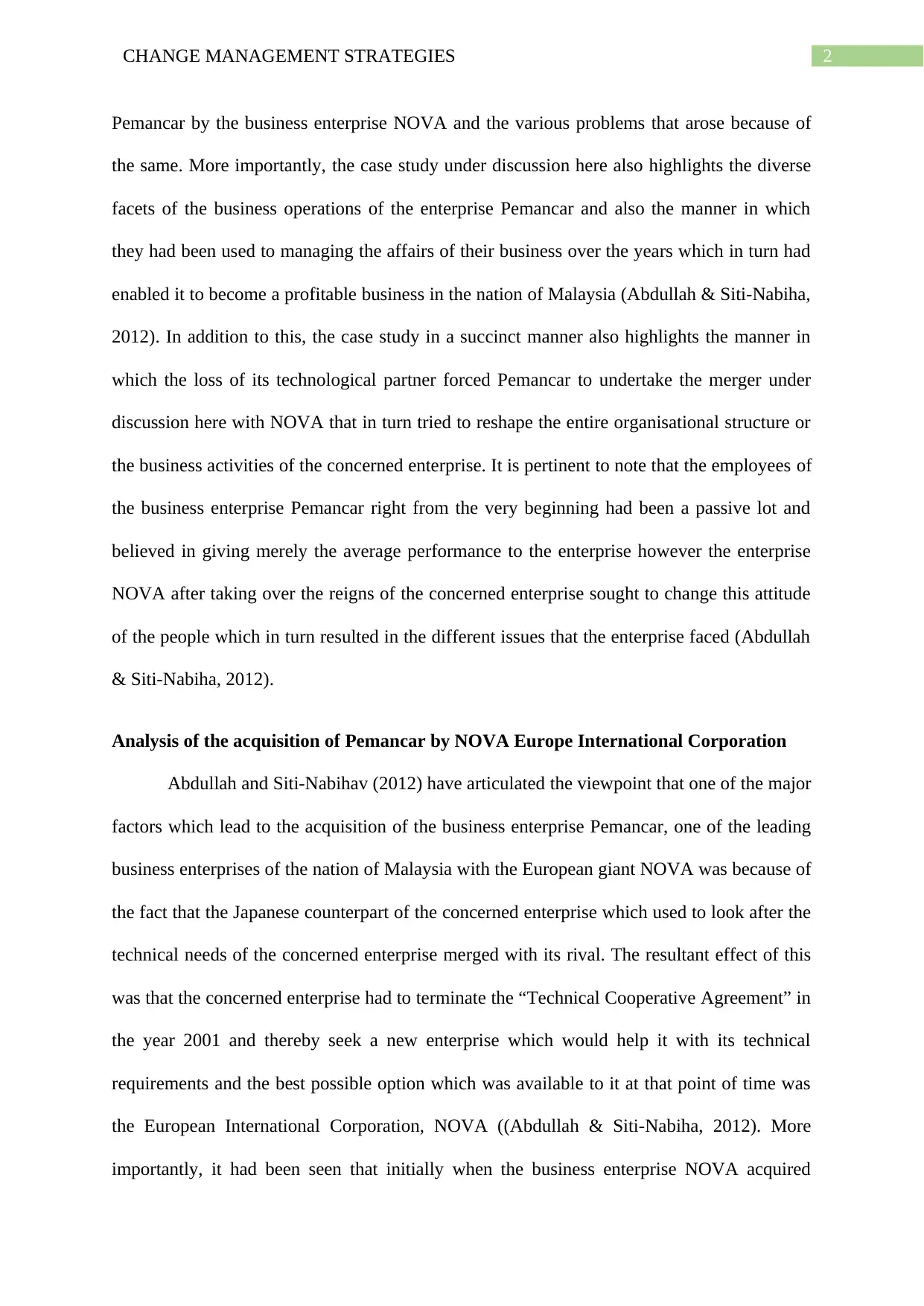
2CHANGE MANAGEMENT STRATEGIES
Pemancar by the business enterprise NOVA and the various problems that arose because of
the same. More importantly, the case study under discussion here also highlights the diverse
facets of the business operations of the enterprise Pemancar and also the manner in which
they had been used to managing the affairs of their business over the years which in turn had
enabled it to become a profitable business in the nation of Malaysia (Abdullah & Siti-Nabiha,
2012). In addition to this, the case study in a succinct manner also highlights the manner in
which the loss of its technological partner forced Pemancar to undertake the merger under
discussion here with NOVA that in turn tried to reshape the entire organisational structure or
the business activities of the concerned enterprise. It is pertinent to note that the employees of
the business enterprise Pemancar right from the very beginning had been a passive lot and
believed in giving merely the average performance to the enterprise however the enterprise
NOVA after taking over the reigns of the concerned enterprise sought to change this attitude
of the people which in turn resulted in the different issues that the enterprise faced (Abdullah
& Siti-Nabiha, 2012).
Analysis of the acquisition of Pemancar by NOVA Europe International Corporation
Abdullah and Siti-Nabihav (2012) have articulated the viewpoint that one of the major
factors which lead to the acquisition of the business enterprise Pemancar, one of the leading
business enterprises of the nation of Malaysia with the European giant NOVA was because of
the fact that the Japanese counterpart of the concerned enterprise which used to look after the
technical needs of the concerned enterprise merged with its rival. The resultant effect of this
was that the concerned enterprise had to terminate the “Technical Cooperative Agreement” in
the year 2001 and thereby seek a new enterprise which would help it with its technical
requirements and the best possible option which was available to it at that point of time was
the European International Corporation, NOVA ((Abdullah & Siti-Nabiha, 2012). More
importantly, it had been seen that initially when the business enterprise NOVA acquired
Pemancar by the business enterprise NOVA and the various problems that arose because of
the same. More importantly, the case study under discussion here also highlights the diverse
facets of the business operations of the enterprise Pemancar and also the manner in which
they had been used to managing the affairs of their business over the years which in turn had
enabled it to become a profitable business in the nation of Malaysia (Abdullah & Siti-Nabiha,
2012). In addition to this, the case study in a succinct manner also highlights the manner in
which the loss of its technological partner forced Pemancar to undertake the merger under
discussion here with NOVA that in turn tried to reshape the entire organisational structure or
the business activities of the concerned enterprise. It is pertinent to note that the employees of
the business enterprise Pemancar right from the very beginning had been a passive lot and
believed in giving merely the average performance to the enterprise however the enterprise
NOVA after taking over the reigns of the concerned enterprise sought to change this attitude
of the people which in turn resulted in the different issues that the enterprise faced (Abdullah
& Siti-Nabiha, 2012).
Analysis of the acquisition of Pemancar by NOVA Europe International Corporation
Abdullah and Siti-Nabihav (2012) have articulated the viewpoint that one of the major
factors which lead to the acquisition of the business enterprise Pemancar, one of the leading
business enterprises of the nation of Malaysia with the European giant NOVA was because of
the fact that the Japanese counterpart of the concerned enterprise which used to look after the
technical needs of the concerned enterprise merged with its rival. The resultant effect of this
was that the concerned enterprise had to terminate the “Technical Cooperative Agreement” in
the year 2001 and thereby seek a new enterprise which would help it with its technical
requirements and the best possible option which was available to it at that point of time was
the European International Corporation, NOVA ((Abdullah & Siti-Nabiha, 2012). More
importantly, it had been seen that initially when the business enterprise NOVA acquired
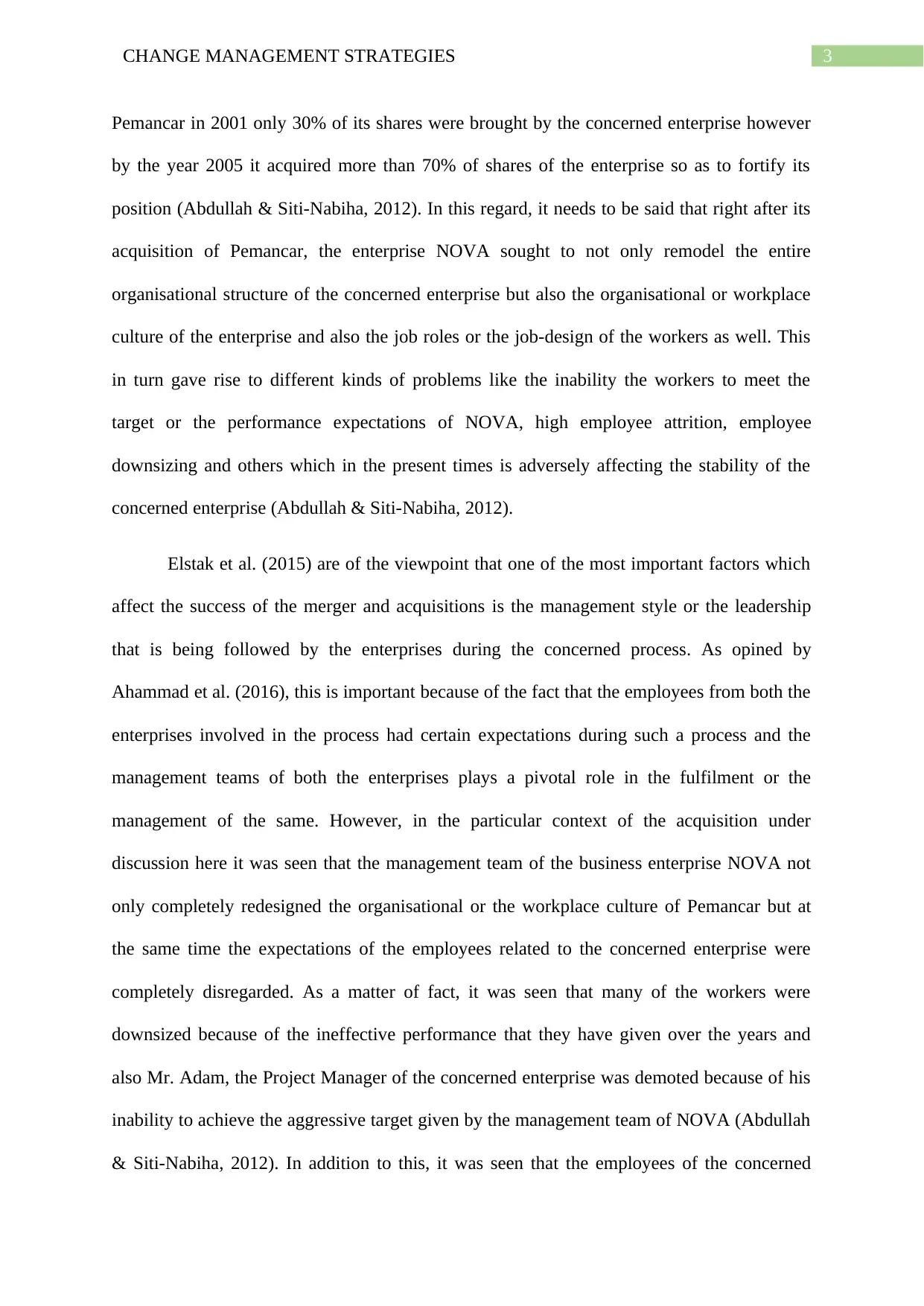
3CHANGE MANAGEMENT STRATEGIES
Pemancar in 2001 only 30% of its shares were brought by the concerned enterprise however
by the year 2005 it acquired more than 70% of shares of the enterprise so as to fortify its
position (Abdullah & Siti-Nabiha, 2012). In this regard, it needs to be said that right after its
acquisition of Pemancar, the enterprise NOVA sought to not only remodel the entire
organisational structure of the concerned enterprise but also the organisational or workplace
culture of the enterprise and also the job roles or the job-design of the workers as well. This
in turn gave rise to different kinds of problems like the inability the workers to meet the
target or the performance expectations of NOVA, high employee attrition, employee
downsizing and others which in the present times is adversely affecting the stability of the
concerned enterprise (Abdullah & Siti-Nabiha, 2012).
Elstak et al. (2015) are of the viewpoint that one of the most important factors which
affect the success of the merger and acquisitions is the management style or the leadership
that is being followed by the enterprises during the concerned process. As opined by
Ahammad et al. (2016), this is important because of the fact that the employees from both the
enterprises involved in the process had certain expectations during such a process and the
management teams of both the enterprises plays a pivotal role in the fulfilment or the
management of the same. However, in the particular context of the acquisition under
discussion here it was seen that the management team of the business enterprise NOVA not
only completely redesigned the organisational or the workplace culture of Pemancar but at
the same time the expectations of the employees related to the concerned enterprise were
completely disregarded. As a matter of fact, it was seen that many of the workers were
downsized because of the ineffective performance that they have given over the years and
also Mr. Adam, the Project Manager of the concerned enterprise was demoted because of his
inability to achieve the aggressive target given by the management team of NOVA (Abdullah
& Siti-Nabiha, 2012). In addition to this, it was seen that the employees of the concerned
Pemancar in 2001 only 30% of its shares were brought by the concerned enterprise however
by the year 2005 it acquired more than 70% of shares of the enterprise so as to fortify its
position (Abdullah & Siti-Nabiha, 2012). In this regard, it needs to be said that right after its
acquisition of Pemancar, the enterprise NOVA sought to not only remodel the entire
organisational structure of the concerned enterprise but also the organisational or workplace
culture of the enterprise and also the job roles or the job-design of the workers as well. This
in turn gave rise to different kinds of problems like the inability the workers to meet the
target or the performance expectations of NOVA, high employee attrition, employee
downsizing and others which in the present times is adversely affecting the stability of the
concerned enterprise (Abdullah & Siti-Nabiha, 2012).
Elstak et al. (2015) are of the viewpoint that one of the most important factors which
affect the success of the merger and acquisitions is the management style or the leadership
that is being followed by the enterprises during the concerned process. As opined by
Ahammad et al. (2016), this is important because of the fact that the employees from both the
enterprises involved in the process had certain expectations during such a process and the
management teams of both the enterprises plays a pivotal role in the fulfilment or the
management of the same. However, in the particular context of the acquisition under
discussion here it was seen that the management team of the business enterprise NOVA not
only completely redesigned the organisational or the workplace culture of Pemancar but at
the same time the expectations of the employees related to the concerned enterprise were
completely disregarded. As a matter of fact, it was seen that many of the workers were
downsized because of the ineffective performance that they have given over the years and
also Mr. Adam, the Project Manager of the concerned enterprise was demoted because of his
inability to achieve the aggressive target given by the management team of NOVA (Abdullah
& Siti-Nabiha, 2012). In addition to this, it was seen that the employees of the concerned
Secure Best Marks with AI Grader
Need help grading? Try our AI Grader for instant feedback on your assignments.
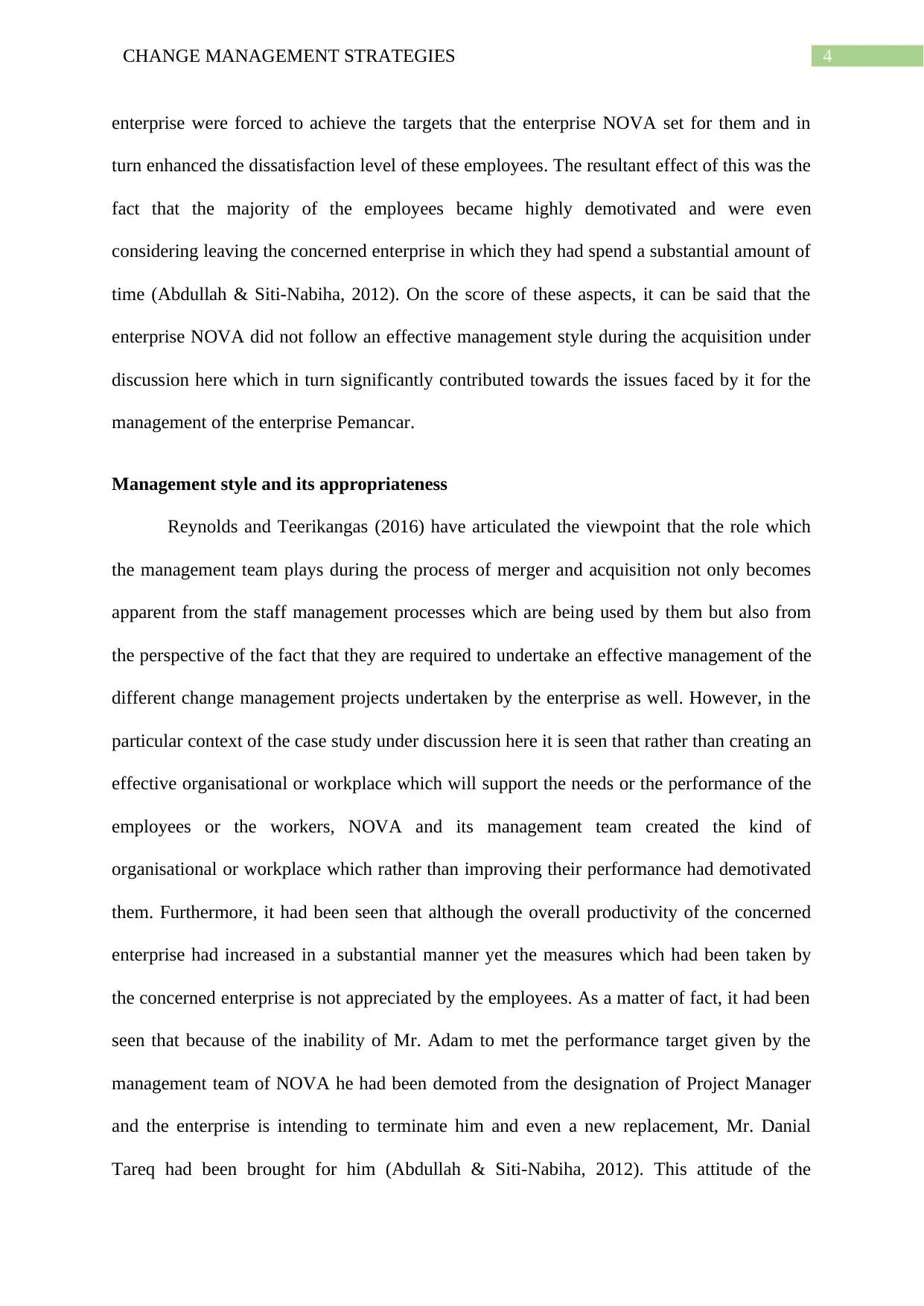
4CHANGE MANAGEMENT STRATEGIES
enterprise were forced to achieve the targets that the enterprise NOVA set for them and in
turn enhanced the dissatisfaction level of these employees. The resultant effect of this was the
fact that the majority of the employees became highly demotivated and were even
considering leaving the concerned enterprise in which they had spend a substantial amount of
time (Abdullah & Siti-Nabiha, 2012). On the score of these aspects, it can be said that the
enterprise NOVA did not follow an effective management style during the acquisition under
discussion here which in turn significantly contributed towards the issues faced by it for the
management of the enterprise Pemancar.
Management style and its appropriateness
Reynolds and Teerikangas (2016) have articulated the viewpoint that the role which
the management team plays during the process of merger and acquisition not only becomes
apparent from the staff management processes which are being used by them but also from
the perspective of the fact that they are required to undertake an effective management of the
different change management projects undertaken by the enterprise as well. However, in the
particular context of the case study under discussion here it is seen that rather than creating an
effective organisational or workplace which will support the needs or the performance of the
employees or the workers, NOVA and its management team created the kind of
organisational or workplace which rather than improving their performance had demotivated
them. Furthermore, it had been seen that although the overall productivity of the concerned
enterprise had increased in a substantial manner yet the measures which had been taken by
the concerned enterprise is not appreciated by the employees. As a matter of fact, it had been
seen that because of the inability of Mr. Adam to met the performance target given by the
management team of NOVA he had been demoted from the designation of Project Manager
and the enterprise is intending to terminate him and even a new replacement, Mr. Danial
Tareq had been brought for him (Abdullah & Siti-Nabiha, 2012). This attitude of the
enterprise were forced to achieve the targets that the enterprise NOVA set for them and in
turn enhanced the dissatisfaction level of these employees. The resultant effect of this was the
fact that the majority of the employees became highly demotivated and were even
considering leaving the concerned enterprise in which they had spend a substantial amount of
time (Abdullah & Siti-Nabiha, 2012). On the score of these aspects, it can be said that the
enterprise NOVA did not follow an effective management style during the acquisition under
discussion here which in turn significantly contributed towards the issues faced by it for the
management of the enterprise Pemancar.
Management style and its appropriateness
Reynolds and Teerikangas (2016) have articulated the viewpoint that the role which
the management team plays during the process of merger and acquisition not only becomes
apparent from the staff management processes which are being used by them but also from
the perspective of the fact that they are required to undertake an effective management of the
different change management projects undertaken by the enterprise as well. However, in the
particular context of the case study under discussion here it is seen that rather than creating an
effective organisational or workplace which will support the needs or the performance of the
employees or the workers, NOVA and its management team created the kind of
organisational or workplace which rather than improving their performance had demotivated
them. Furthermore, it had been seen that although the overall productivity of the concerned
enterprise had increased in a substantial manner yet the measures which had been taken by
the concerned enterprise is not appreciated by the employees. As a matter of fact, it had been
seen that because of the inability of Mr. Adam to met the performance target given by the
management team of NOVA he had been demoted from the designation of Project Manager
and the enterprise is intending to terminate him and even a new replacement, Mr. Danial
Tareq had been brought for him (Abdullah & Siti-Nabiha, 2012). This attitude of the
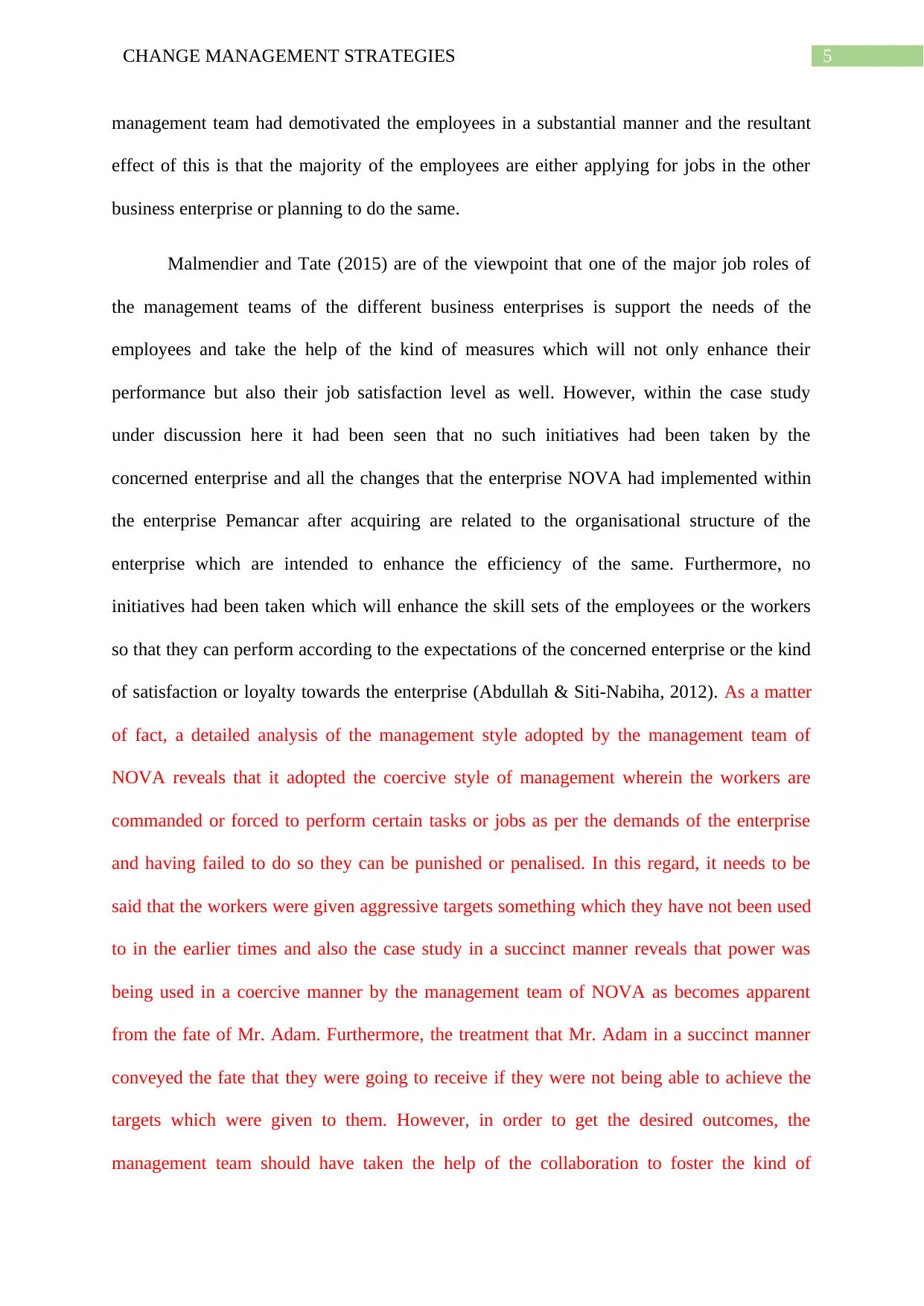
5CHANGE MANAGEMENT STRATEGIES
management team had demotivated the employees in a substantial manner and the resultant
effect of this is that the majority of the employees are either applying for jobs in the other
business enterprise or planning to do the same.
Malmendier and Tate (2015) are of the viewpoint that one of the major job roles of
the management teams of the different business enterprises is support the needs of the
employees and take the help of the kind of measures which will not only enhance their
performance but also their job satisfaction level as well. However, within the case study
under discussion here it had been seen that no such initiatives had been taken by the
concerned enterprise and all the changes that the enterprise NOVA had implemented within
the enterprise Pemancar after acquiring are related to the organisational structure of the
enterprise which are intended to enhance the efficiency of the same. Furthermore, no
initiatives had been taken which will enhance the skill sets of the employees or the workers
so that they can perform according to the expectations of the concerned enterprise or the kind
of satisfaction or loyalty towards the enterprise (Abdullah & Siti-Nabiha, 2012). As a matter
of fact, a detailed analysis of the management style adopted by the management team of
NOVA reveals that it adopted the coercive style of management wherein the workers are
commanded or forced to perform certain tasks or jobs as per the demands of the enterprise
and having failed to do so they can be punished or penalised. In this regard, it needs to be
said that the workers were given aggressive targets something which they have not been used
to in the earlier times and also the case study in a succinct manner reveals that power was
being used in a coercive manner by the management team of NOVA as becomes apparent
from the fate of Mr. Adam. Furthermore, the treatment that Mr. Adam in a succinct manner
conveyed the fate that they were going to receive if they were not being able to achieve the
targets which were given to them. However, in order to get the desired outcomes, the
management team should have taken the help of the collaboration to foster the kind of
management team had demotivated the employees in a substantial manner and the resultant
effect of this is that the majority of the employees are either applying for jobs in the other
business enterprise or planning to do the same.
Malmendier and Tate (2015) are of the viewpoint that one of the major job roles of
the management teams of the different business enterprises is support the needs of the
employees and take the help of the kind of measures which will not only enhance their
performance but also their job satisfaction level as well. However, within the case study
under discussion here it had been seen that no such initiatives had been taken by the
concerned enterprise and all the changes that the enterprise NOVA had implemented within
the enterprise Pemancar after acquiring are related to the organisational structure of the
enterprise which are intended to enhance the efficiency of the same. Furthermore, no
initiatives had been taken which will enhance the skill sets of the employees or the workers
so that they can perform according to the expectations of the concerned enterprise or the kind
of satisfaction or loyalty towards the enterprise (Abdullah & Siti-Nabiha, 2012). As a matter
of fact, a detailed analysis of the management style adopted by the management team of
NOVA reveals that it adopted the coercive style of management wherein the workers are
commanded or forced to perform certain tasks or jobs as per the demands of the enterprise
and having failed to do so they can be punished or penalised. In this regard, it needs to be
said that the workers were given aggressive targets something which they have not been used
to in the earlier times and also the case study in a succinct manner reveals that power was
being used in a coercive manner by the management team of NOVA as becomes apparent
from the fate of Mr. Adam. Furthermore, the treatment that Mr. Adam in a succinct manner
conveyed the fate that they were going to receive if they were not being able to achieve the
targets which were given to them. However, in order to get the desired outcomes, the
management team should have taken the help of the collaboration to foster the kind of
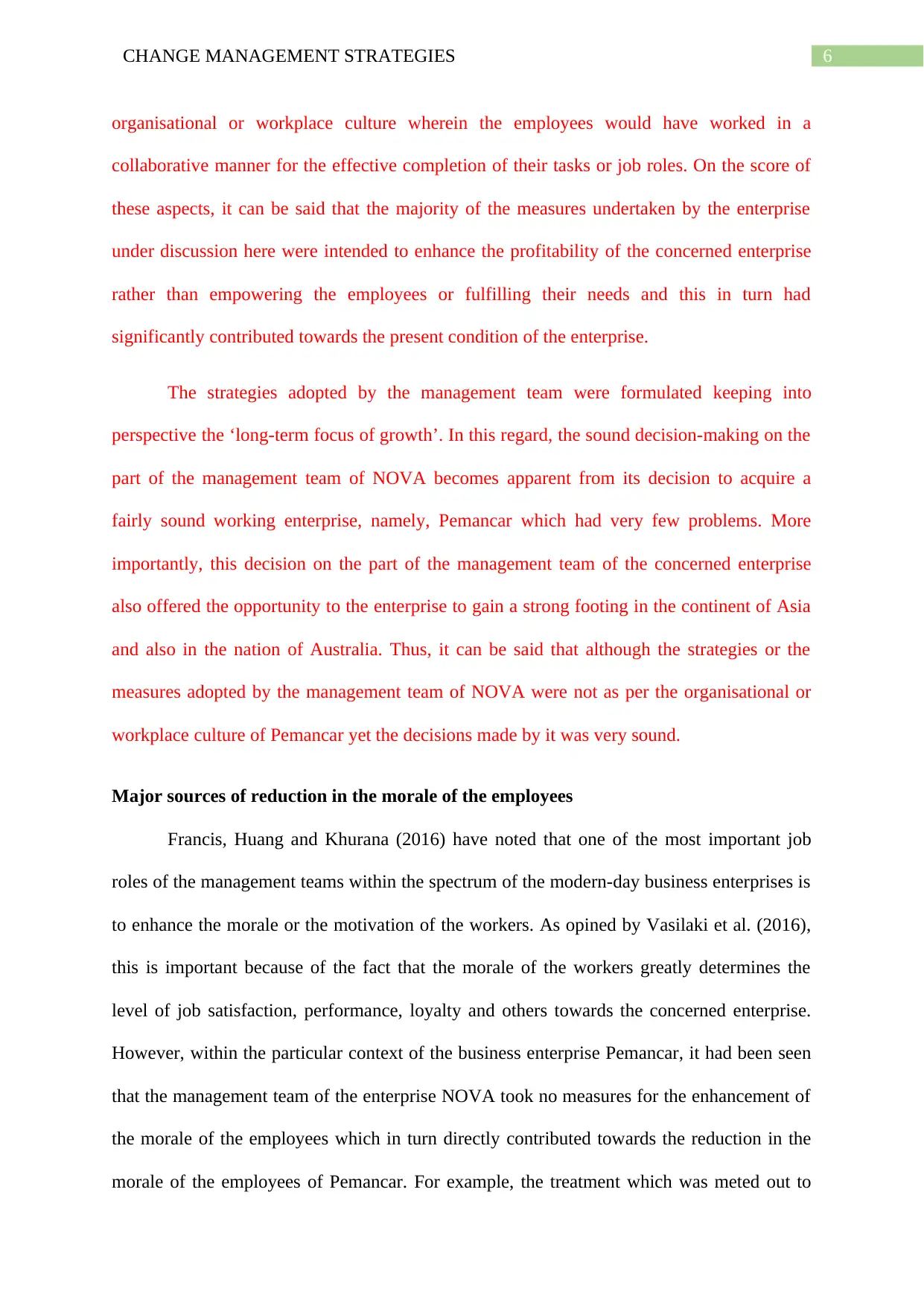
6CHANGE MANAGEMENT STRATEGIES
organisational or workplace culture wherein the employees would have worked in a
collaborative manner for the effective completion of their tasks or job roles. On the score of
these aspects, it can be said that the majority of the measures undertaken by the enterprise
under discussion here were intended to enhance the profitability of the concerned enterprise
rather than empowering the employees or fulfilling their needs and this in turn had
significantly contributed towards the present condition of the enterprise.
The strategies adopted by the management team were formulated keeping into
perspective the ‘long-term focus of growth’. In this regard, the sound decision-making on the
part of the management team of NOVA becomes apparent from its decision to acquire a
fairly sound working enterprise, namely, Pemancar which had very few problems. More
importantly, this decision on the part of the management team of the concerned enterprise
also offered the opportunity to the enterprise to gain a strong footing in the continent of Asia
and also in the nation of Australia. Thus, it can be said that although the strategies or the
measures adopted by the management team of NOVA were not as per the organisational or
workplace culture of Pemancar yet the decisions made by it was very sound.
Major sources of reduction in the morale of the employees
Francis, Huang and Khurana (2016) have noted that one of the most important job
roles of the management teams within the spectrum of the modern-day business enterprises is
to enhance the morale or the motivation of the workers. As opined by Vasilaki et al. (2016),
this is important because of the fact that the morale of the workers greatly determines the
level of job satisfaction, performance, loyalty and others towards the concerned enterprise.
However, within the particular context of the business enterprise Pemancar, it had been seen
that the management team of the enterprise NOVA took no measures for the enhancement of
the morale of the employees which in turn directly contributed towards the reduction in the
morale of the employees of Pemancar. For example, the treatment which was meted out to
organisational or workplace culture wherein the employees would have worked in a
collaborative manner for the effective completion of their tasks or job roles. On the score of
these aspects, it can be said that the majority of the measures undertaken by the enterprise
under discussion here were intended to enhance the profitability of the concerned enterprise
rather than empowering the employees or fulfilling their needs and this in turn had
significantly contributed towards the present condition of the enterprise.
The strategies adopted by the management team were formulated keeping into
perspective the ‘long-term focus of growth’. In this regard, the sound decision-making on the
part of the management team of NOVA becomes apparent from its decision to acquire a
fairly sound working enterprise, namely, Pemancar which had very few problems. More
importantly, this decision on the part of the management team of the concerned enterprise
also offered the opportunity to the enterprise to gain a strong footing in the continent of Asia
and also in the nation of Australia. Thus, it can be said that although the strategies or the
measures adopted by the management team of NOVA were not as per the organisational or
workplace culture of Pemancar yet the decisions made by it was very sound.
Major sources of reduction in the morale of the employees
Francis, Huang and Khurana (2016) have noted that one of the most important job
roles of the management teams within the spectrum of the modern-day business enterprises is
to enhance the morale or the motivation of the workers. As opined by Vasilaki et al. (2016),
this is important because of the fact that the morale of the workers greatly determines the
level of job satisfaction, performance, loyalty and others towards the concerned enterprise.
However, within the particular context of the business enterprise Pemancar, it had been seen
that the management team of the enterprise NOVA took no measures for the enhancement of
the morale of the employees which in turn directly contributed towards the reduction in the
morale of the employees of Pemancar. For example, the treatment which was meted out to
Paraphrase This Document
Need a fresh take? Get an instant paraphrase of this document with our AI Paraphraser
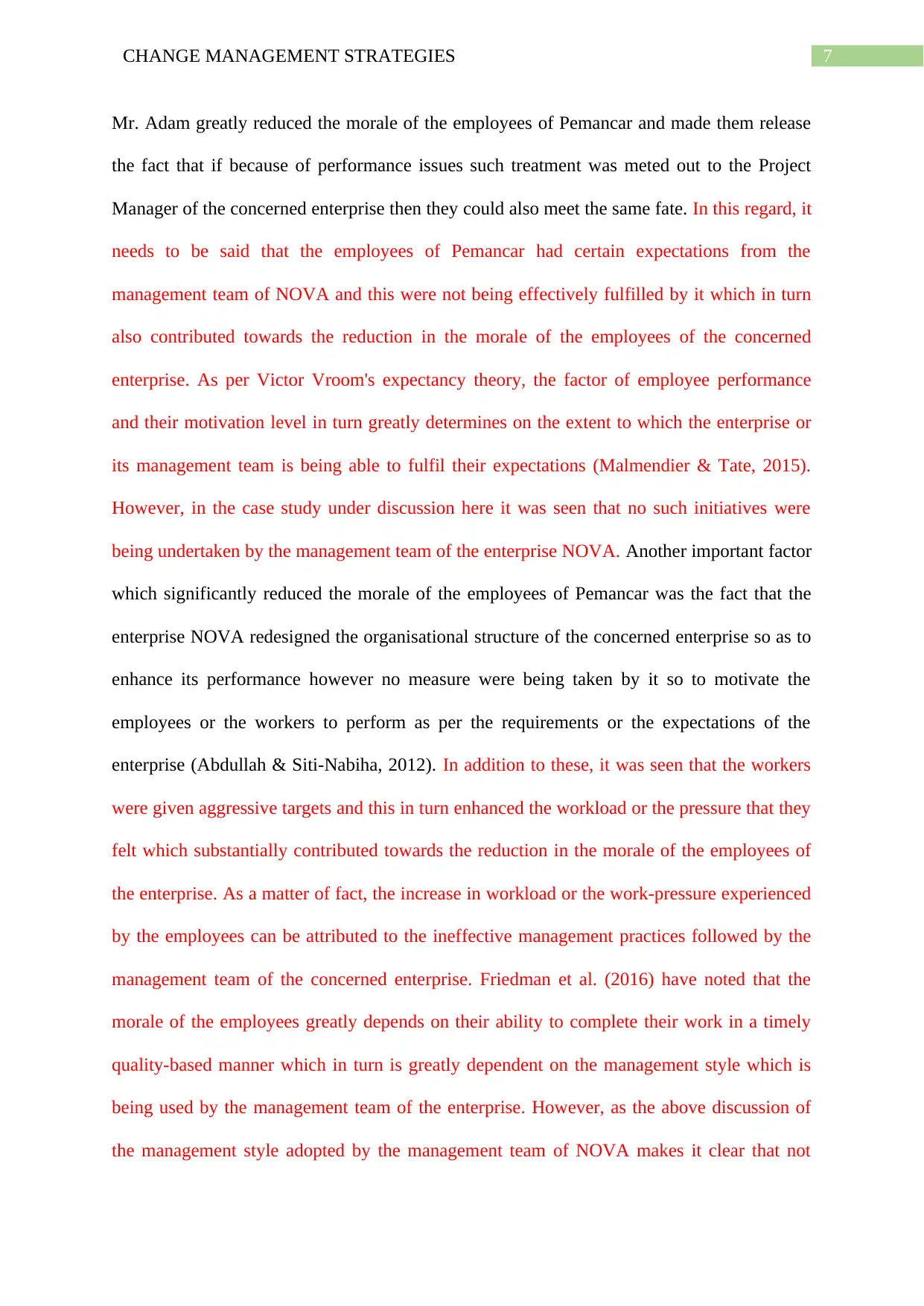
7CHANGE MANAGEMENT STRATEGIES
Mr. Adam greatly reduced the morale of the employees of Pemancar and made them release
the fact that if because of performance issues such treatment was meted out to the Project
Manager of the concerned enterprise then they could also meet the same fate. In this regard, it
needs to be said that the employees of Pemancar had certain expectations from the
management team of NOVA and this were not being effectively fulfilled by it which in turn
also contributed towards the reduction in the morale of the employees of the concerned
enterprise. As per Victor Vroom's expectancy theory, the factor of employee performance
and their motivation level in turn greatly determines on the extent to which the enterprise or
its management team is being able to fulfil their expectations (Malmendier & Tate, 2015).
However, in the case study under discussion here it was seen that no such initiatives were
being undertaken by the management team of the enterprise NOVA. Another important factor
which significantly reduced the morale of the employees of Pemancar was the fact that the
enterprise NOVA redesigned the organisational structure of the concerned enterprise so as to
enhance its performance however no measure were being taken by it so to motivate the
employees or the workers to perform as per the requirements or the expectations of the
enterprise (Abdullah & Siti-Nabiha, 2012). In addition to these, it was seen that the workers
were given aggressive targets and this in turn enhanced the workload or the pressure that they
felt which substantially contributed towards the reduction in the morale of the employees of
the enterprise. As a matter of fact, the increase in workload or the work-pressure experienced
by the employees can be attributed to the ineffective management practices followed by the
management team of the concerned enterprise. Friedman et al. (2016) have noted that the
morale of the employees greatly depends on their ability to complete their work in a timely
quality-based manner which in turn is greatly dependent on the management style which is
being used by the management team of the enterprise. However, as the above discussion of
the management style adopted by the management team of NOVA makes it clear that not
Mr. Adam greatly reduced the morale of the employees of Pemancar and made them release
the fact that if because of performance issues such treatment was meted out to the Project
Manager of the concerned enterprise then they could also meet the same fate. In this regard, it
needs to be said that the employees of Pemancar had certain expectations from the
management team of NOVA and this were not being effectively fulfilled by it which in turn
also contributed towards the reduction in the morale of the employees of the concerned
enterprise. As per Victor Vroom's expectancy theory, the factor of employee performance
and their motivation level in turn greatly determines on the extent to which the enterprise or
its management team is being able to fulfil their expectations (Malmendier & Tate, 2015).
However, in the case study under discussion here it was seen that no such initiatives were
being undertaken by the management team of the enterprise NOVA. Another important factor
which significantly reduced the morale of the employees of Pemancar was the fact that the
enterprise NOVA redesigned the organisational structure of the concerned enterprise so as to
enhance its performance however no measure were being taken by it so to motivate the
employees or the workers to perform as per the requirements or the expectations of the
enterprise (Abdullah & Siti-Nabiha, 2012). In addition to these, it was seen that the workers
were given aggressive targets and this in turn enhanced the workload or the pressure that they
felt which substantially contributed towards the reduction in the morale of the employees of
the enterprise. As a matter of fact, the increase in workload or the work-pressure experienced
by the employees can be attributed to the ineffective management practices followed by the
management team of the concerned enterprise. Friedman et al. (2016) have noted that the
morale of the employees greatly depends on their ability to complete their work in a timely
quality-based manner which in turn is greatly dependent on the management style which is
being used by the management team of the enterprise. However, as the above discussion of
the management style adopted by the management team of NOVA makes it clear that not
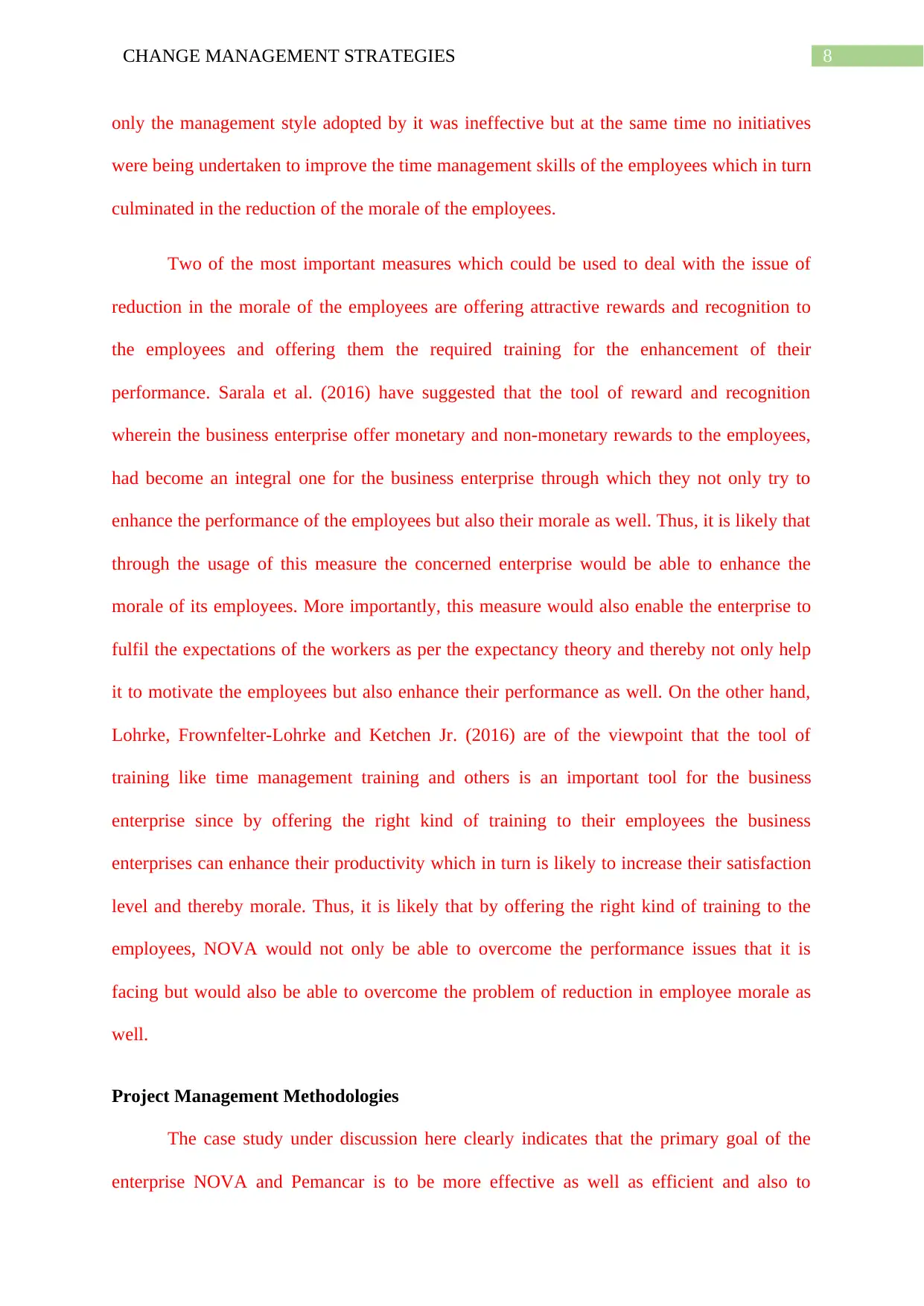
8CHANGE MANAGEMENT STRATEGIES
only the management style adopted by it was ineffective but at the same time no initiatives
were being undertaken to improve the time management skills of the employees which in turn
culminated in the reduction of the morale of the employees.
Two of the most important measures which could be used to deal with the issue of
reduction in the morale of the employees are offering attractive rewards and recognition to
the employees and offering them the required training for the enhancement of their
performance. Sarala et al. (2016) have suggested that the tool of reward and recognition
wherein the business enterprise offer monetary and non-monetary rewards to the employees,
had become an integral one for the business enterprise through which they not only try to
enhance the performance of the employees but also their morale as well. Thus, it is likely that
through the usage of this measure the concerned enterprise would be able to enhance the
morale of its employees. More importantly, this measure would also enable the enterprise to
fulfil the expectations of the workers as per the expectancy theory and thereby not only help
it to motivate the employees but also enhance their performance as well. On the other hand,
Lohrke, Frownfelter-Lohrke and Ketchen Jr. (2016) are of the viewpoint that the tool of
training like time management training and others is an important tool for the business
enterprise since by offering the right kind of training to their employees the business
enterprises can enhance their productivity which in turn is likely to increase their satisfaction
level and thereby morale. Thus, it is likely that by offering the right kind of training to the
employees, NOVA would not only be able to overcome the performance issues that it is
facing but would also be able to overcome the problem of reduction in employee morale as
well.
Project Management Methodologies
The case study under discussion here clearly indicates that the primary goal of the
enterprise NOVA and Pemancar is to be more effective as well as efficient and also to
only the management style adopted by it was ineffective but at the same time no initiatives
were being undertaken to improve the time management skills of the employees which in turn
culminated in the reduction of the morale of the employees.
Two of the most important measures which could be used to deal with the issue of
reduction in the morale of the employees are offering attractive rewards and recognition to
the employees and offering them the required training for the enhancement of their
performance. Sarala et al. (2016) have suggested that the tool of reward and recognition
wherein the business enterprise offer monetary and non-monetary rewards to the employees,
had become an integral one for the business enterprise through which they not only try to
enhance the performance of the employees but also their morale as well. Thus, it is likely that
through the usage of this measure the concerned enterprise would be able to enhance the
morale of its employees. More importantly, this measure would also enable the enterprise to
fulfil the expectations of the workers as per the expectancy theory and thereby not only help
it to motivate the employees but also enhance their performance as well. On the other hand,
Lohrke, Frownfelter-Lohrke and Ketchen Jr. (2016) are of the viewpoint that the tool of
training like time management training and others is an important tool for the business
enterprise since by offering the right kind of training to their employees the business
enterprises can enhance their productivity which in turn is likely to increase their satisfaction
level and thereby morale. Thus, it is likely that by offering the right kind of training to the
employees, NOVA would not only be able to overcome the performance issues that it is
facing but would also be able to overcome the problem of reduction in employee morale as
well.
Project Management Methodologies
The case study under discussion here clearly indicates that the primary goal of the
enterprise NOVA and Pemancar is to be more effective as well as efficient and also to
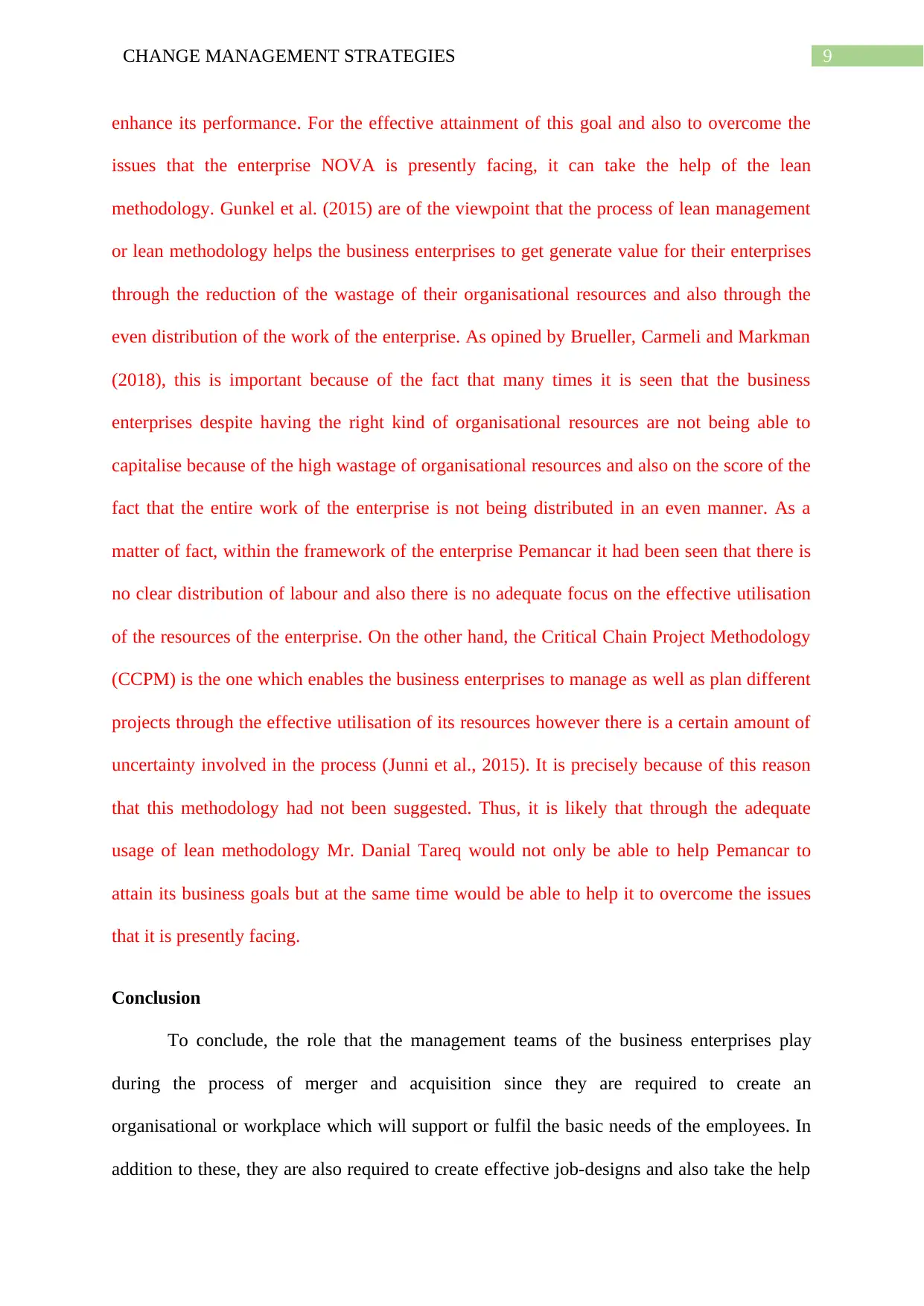
9CHANGE MANAGEMENT STRATEGIES
enhance its performance. For the effective attainment of this goal and also to overcome the
issues that the enterprise NOVA is presently facing, it can take the help of the lean
methodology. Gunkel et al. (2015) are of the viewpoint that the process of lean management
or lean methodology helps the business enterprises to get generate value for their enterprises
through the reduction of the wastage of their organisational resources and also through the
even distribution of the work of the enterprise. As opined by Brueller, Carmeli and Markman
(2018), this is important because of the fact that many times it is seen that the business
enterprises despite having the right kind of organisational resources are not being able to
capitalise because of the high wastage of organisational resources and also on the score of the
fact that the entire work of the enterprise is not being distributed in an even manner. As a
matter of fact, within the framework of the enterprise Pemancar it had been seen that there is
no clear distribution of labour and also there is no adequate focus on the effective utilisation
of the resources of the enterprise. On the other hand, the Critical Chain Project Methodology
(CCPM) is the one which enables the business enterprises to manage as well as plan different
projects through the effective utilisation of its resources however there is a certain amount of
uncertainty involved in the process (Junni et al., 2015). It is precisely because of this reason
that this methodology had not been suggested. Thus, it is likely that through the adequate
usage of lean methodology Mr. Danial Tareq would not only be able to help Pemancar to
attain its business goals but at the same time would be able to help it to overcome the issues
that it is presently facing.
Conclusion
To conclude, the role that the management teams of the business enterprises play
during the process of merger and acquisition since they are required to create an
organisational or workplace which will support or fulfil the basic needs of the employees. In
addition to these, they are also required to create effective job-designs and also take the help
enhance its performance. For the effective attainment of this goal and also to overcome the
issues that the enterprise NOVA is presently facing, it can take the help of the lean
methodology. Gunkel et al. (2015) are of the viewpoint that the process of lean management
or lean methodology helps the business enterprises to get generate value for their enterprises
through the reduction of the wastage of their organisational resources and also through the
even distribution of the work of the enterprise. As opined by Brueller, Carmeli and Markman
(2018), this is important because of the fact that many times it is seen that the business
enterprises despite having the right kind of organisational resources are not being able to
capitalise because of the high wastage of organisational resources and also on the score of the
fact that the entire work of the enterprise is not being distributed in an even manner. As a
matter of fact, within the framework of the enterprise Pemancar it had been seen that there is
no clear distribution of labour and also there is no adequate focus on the effective utilisation
of the resources of the enterprise. On the other hand, the Critical Chain Project Methodology
(CCPM) is the one which enables the business enterprises to manage as well as plan different
projects through the effective utilisation of its resources however there is a certain amount of
uncertainty involved in the process (Junni et al., 2015). It is precisely because of this reason
that this methodology had not been suggested. Thus, it is likely that through the adequate
usage of lean methodology Mr. Danial Tareq would not only be able to help Pemancar to
attain its business goals but at the same time would be able to help it to overcome the issues
that it is presently facing.
Conclusion
To conclude, the role that the management teams of the business enterprises play
during the process of merger and acquisition since they are required to create an
organisational or workplace which will support or fulfil the basic needs of the employees. In
addition to these, they are also required to create effective job-designs and also take the help
Secure Best Marks with AI Grader
Need help grading? Try our AI Grader for instant feedback on your assignments.
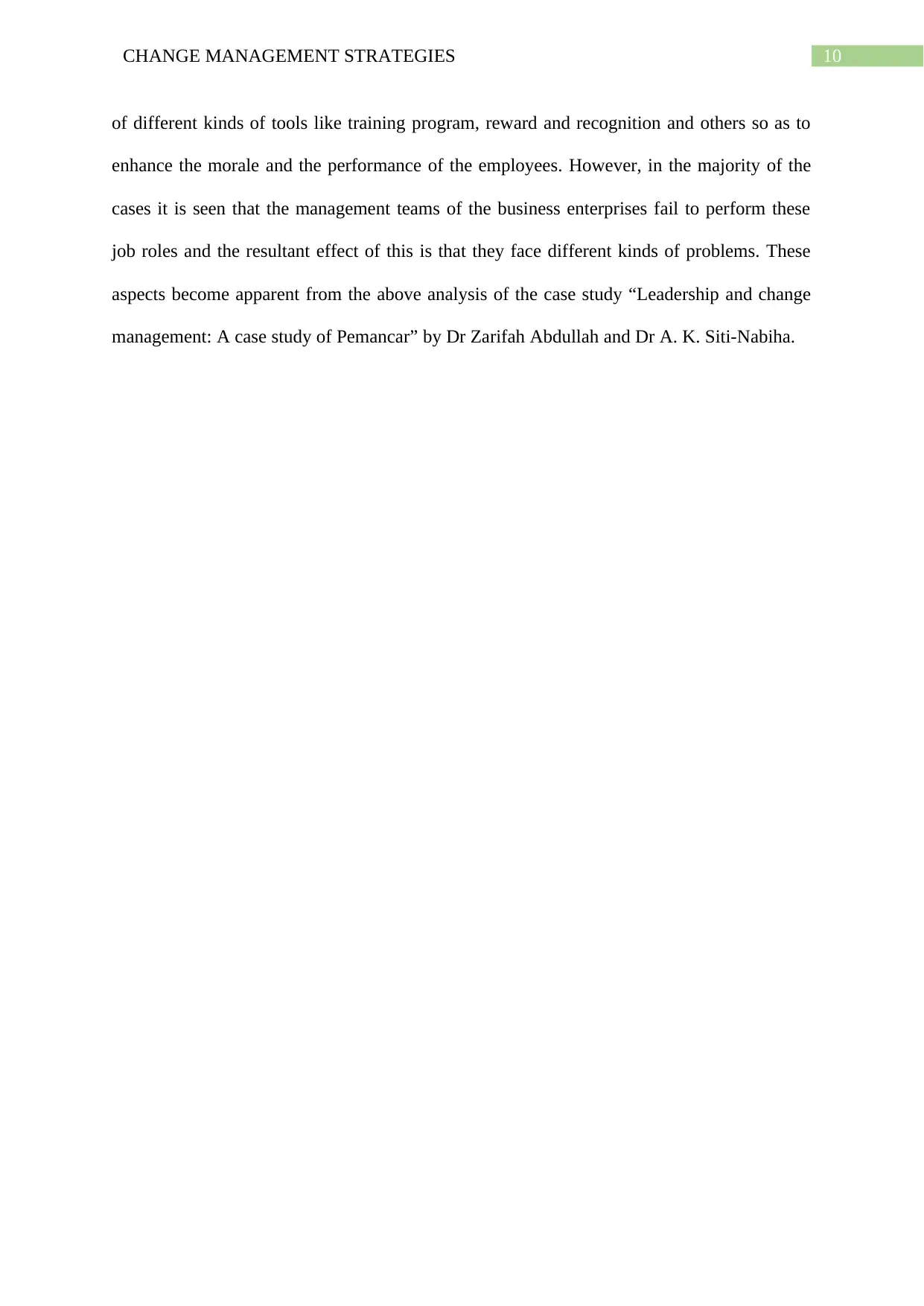
10CHANGE MANAGEMENT STRATEGIES
of different kinds of tools like training program, reward and recognition and others so as to
enhance the morale and the performance of the employees. However, in the majority of the
cases it is seen that the management teams of the business enterprises fail to perform these
job roles and the resultant effect of this is that they face different kinds of problems. These
aspects become apparent from the above analysis of the case study “Leadership and change
management: A case study of Pemancar” by Dr Zarifah Abdullah and Dr A. K. Siti-Nabiha.
of different kinds of tools like training program, reward and recognition and others so as to
enhance the morale and the performance of the employees. However, in the majority of the
cases it is seen that the management teams of the business enterprises fail to perform these
job roles and the resultant effect of this is that they face different kinds of problems. These
aspects become apparent from the above analysis of the case study “Leadership and change
management: A case study of Pemancar” by Dr Zarifah Abdullah and Dr A. K. Siti-Nabiha.
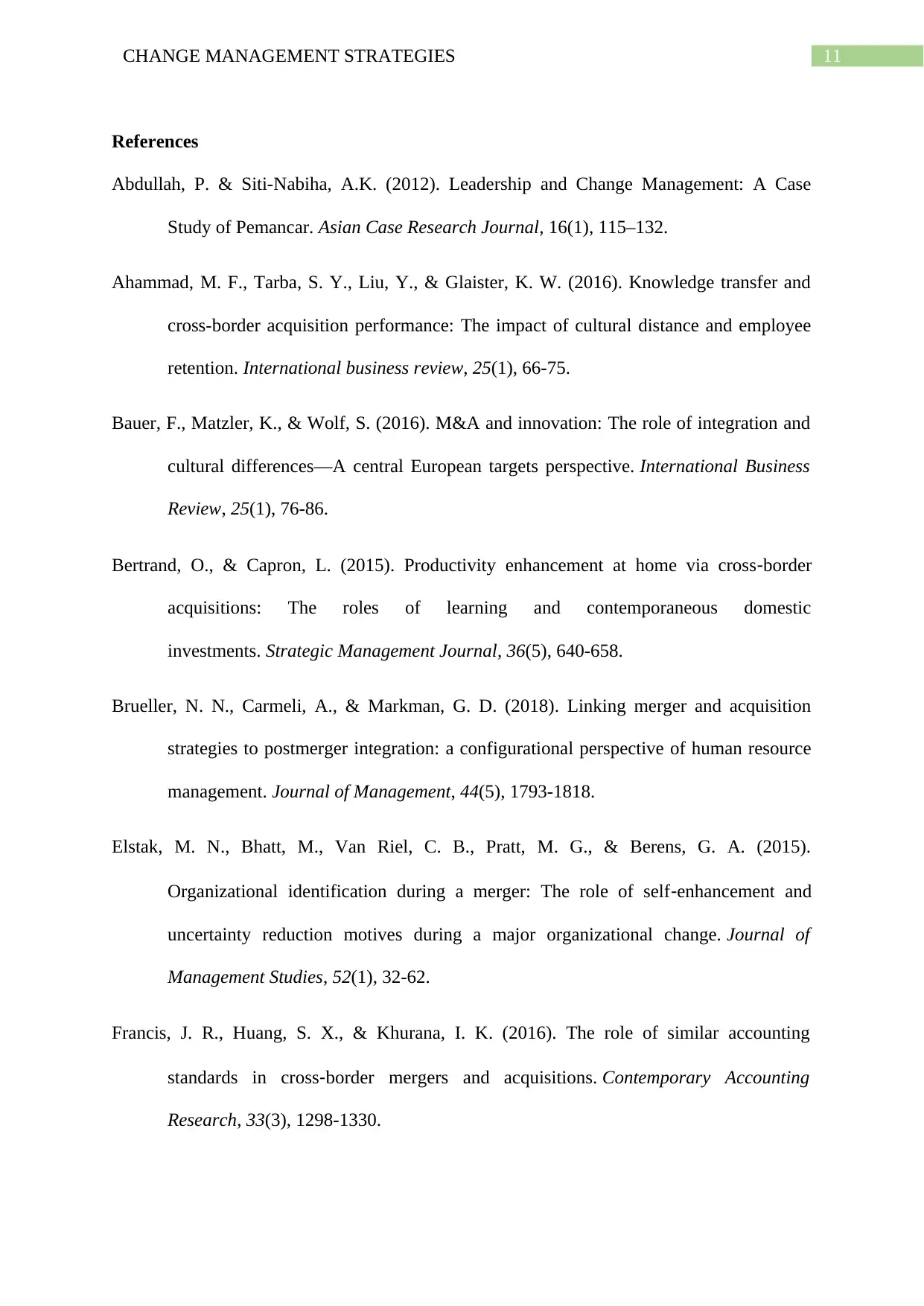
11CHANGE MANAGEMENT STRATEGIES
References
Abdullah, P. & Siti-Nabiha, A.K. (2012). Leadership and Change Management: A Case
Study of Pemancar. Asian Case Research Journal, 16(1), 115–132.
Ahammad, M. F., Tarba, S. Y., Liu, Y., & Glaister, K. W. (2016). Knowledge transfer and
cross-border acquisition performance: The impact of cultural distance and employee
retention. International business review, 25(1), 66-75.
Bauer, F., Matzler, K., & Wolf, S. (2016). M&A and innovation: The role of integration and
cultural differences—A central European targets perspective. International Business
Review, 25(1), 76-86.
Bertrand, O., & Capron, L. (2015). Productivity enhancement at home via cross‐border
acquisitions: The roles of learning and contemporaneous domestic
investments. Strategic Management Journal, 36(5), 640-658.
Brueller, N. N., Carmeli, A., & Markman, G. D. (2018). Linking merger and acquisition
strategies to postmerger integration: a configurational perspective of human resource
management. Journal of Management, 44(5), 1793-1818.
Elstak, M. N., Bhatt, M., Van Riel, C. B., Pratt, M. G., & Berens, G. A. (2015).
Organizational identification during a merger: The role of self‐enhancement and
uncertainty reduction motives during a major organizational change. Journal of
Management Studies, 52(1), 32-62.
Francis, J. R., Huang, S. X., & Khurana, I. K. (2016). The role of similar accounting
standards in cross‐border mergers and acquisitions. Contemporary Accounting
Research, 33(3), 1298-1330.
References
Abdullah, P. & Siti-Nabiha, A.K. (2012). Leadership and Change Management: A Case
Study of Pemancar. Asian Case Research Journal, 16(1), 115–132.
Ahammad, M. F., Tarba, S. Y., Liu, Y., & Glaister, K. W. (2016). Knowledge transfer and
cross-border acquisition performance: The impact of cultural distance and employee
retention. International business review, 25(1), 66-75.
Bauer, F., Matzler, K., & Wolf, S. (2016). M&A and innovation: The role of integration and
cultural differences—A central European targets perspective. International Business
Review, 25(1), 76-86.
Bertrand, O., & Capron, L. (2015). Productivity enhancement at home via cross‐border
acquisitions: The roles of learning and contemporaneous domestic
investments. Strategic Management Journal, 36(5), 640-658.
Brueller, N. N., Carmeli, A., & Markman, G. D. (2018). Linking merger and acquisition
strategies to postmerger integration: a configurational perspective of human resource
management. Journal of Management, 44(5), 1793-1818.
Elstak, M. N., Bhatt, M., Van Riel, C. B., Pratt, M. G., & Berens, G. A. (2015).
Organizational identification during a merger: The role of self‐enhancement and
uncertainty reduction motives during a major organizational change. Journal of
Management Studies, 52(1), 32-62.
Francis, J. R., Huang, S. X., & Khurana, I. K. (2016). The role of similar accounting
standards in cross‐border mergers and acquisitions. Contemporary Accounting
Research, 33(3), 1298-1330.
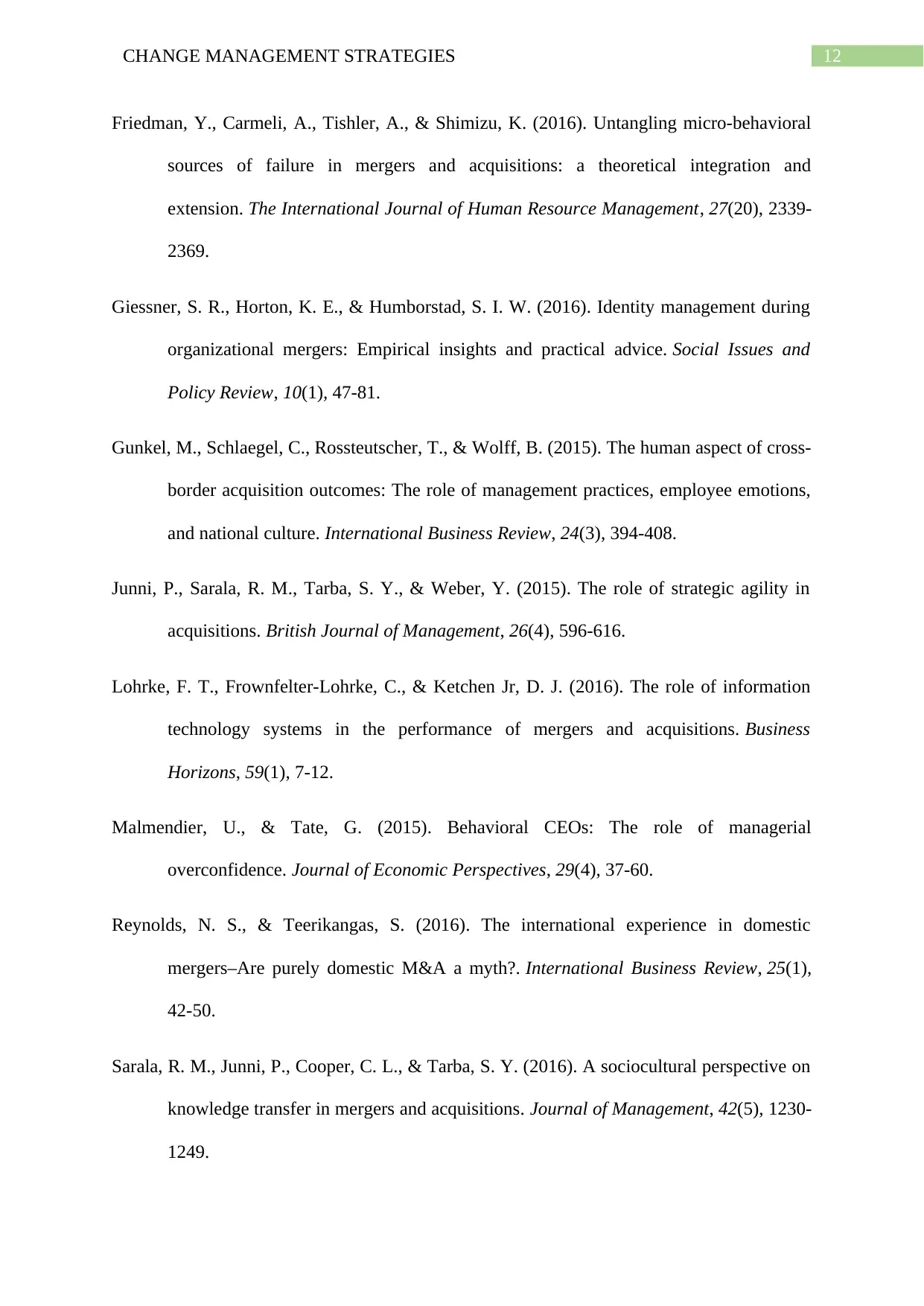
12CHANGE MANAGEMENT STRATEGIES
Friedman, Y., Carmeli, A., Tishler, A., & Shimizu, K. (2016). Untangling micro-behavioral
sources of failure in mergers and acquisitions: a theoretical integration and
extension. The International Journal of Human Resource Management, 27(20), 2339-
2369.
Giessner, S. R., Horton, K. E., & Humborstad, S. I. W. (2016). Identity management during
organizational mergers: Empirical insights and practical advice. Social Issues and
Policy Review, 10(1), 47-81.
Gunkel, M., Schlaegel, C., Rossteutscher, T., & Wolff, B. (2015). The human aspect of cross-
border acquisition outcomes: The role of management practices, employee emotions,
and national culture. International Business Review, 24(3), 394-408.
Junni, P., Sarala, R. M., Tarba, S. Y., & Weber, Y. (2015). The role of strategic agility in
acquisitions. British Journal of Management, 26(4), 596-616.
Lohrke, F. T., Frownfelter-Lohrke, C., & Ketchen Jr, D. J. (2016). The role of information
technology systems in the performance of mergers and acquisitions. Business
Horizons, 59(1), 7-12.
Malmendier, U., & Tate, G. (2015). Behavioral CEOs: The role of managerial
overconfidence. Journal of Economic Perspectives, 29(4), 37-60.
Reynolds, N. S., & Teerikangas, S. (2016). The international experience in domestic
mergers–Are purely domestic M&A a myth?. International Business Review, 25(1),
42-50.
Sarala, R. M., Junni, P., Cooper, C. L., & Tarba, S. Y. (2016). A sociocultural perspective on
knowledge transfer in mergers and acquisitions. Journal of Management, 42(5), 1230-
1249.
Friedman, Y., Carmeli, A., Tishler, A., & Shimizu, K. (2016). Untangling micro-behavioral
sources of failure in mergers and acquisitions: a theoretical integration and
extension. The International Journal of Human Resource Management, 27(20), 2339-
2369.
Giessner, S. R., Horton, K. E., & Humborstad, S. I. W. (2016). Identity management during
organizational mergers: Empirical insights and practical advice. Social Issues and
Policy Review, 10(1), 47-81.
Gunkel, M., Schlaegel, C., Rossteutscher, T., & Wolff, B. (2015). The human aspect of cross-
border acquisition outcomes: The role of management practices, employee emotions,
and national culture. International Business Review, 24(3), 394-408.
Junni, P., Sarala, R. M., Tarba, S. Y., & Weber, Y. (2015). The role of strategic agility in
acquisitions. British Journal of Management, 26(4), 596-616.
Lohrke, F. T., Frownfelter-Lohrke, C., & Ketchen Jr, D. J. (2016). The role of information
technology systems in the performance of mergers and acquisitions. Business
Horizons, 59(1), 7-12.
Malmendier, U., & Tate, G. (2015). Behavioral CEOs: The role of managerial
overconfidence. Journal of Economic Perspectives, 29(4), 37-60.
Reynolds, N. S., & Teerikangas, S. (2016). The international experience in domestic
mergers–Are purely domestic M&A a myth?. International Business Review, 25(1),
42-50.
Sarala, R. M., Junni, P., Cooper, C. L., & Tarba, S. Y. (2016). A sociocultural perspective on
knowledge transfer in mergers and acquisitions. Journal of Management, 42(5), 1230-
1249.
Paraphrase This Document
Need a fresh take? Get an instant paraphrase of this document with our AI Paraphraser
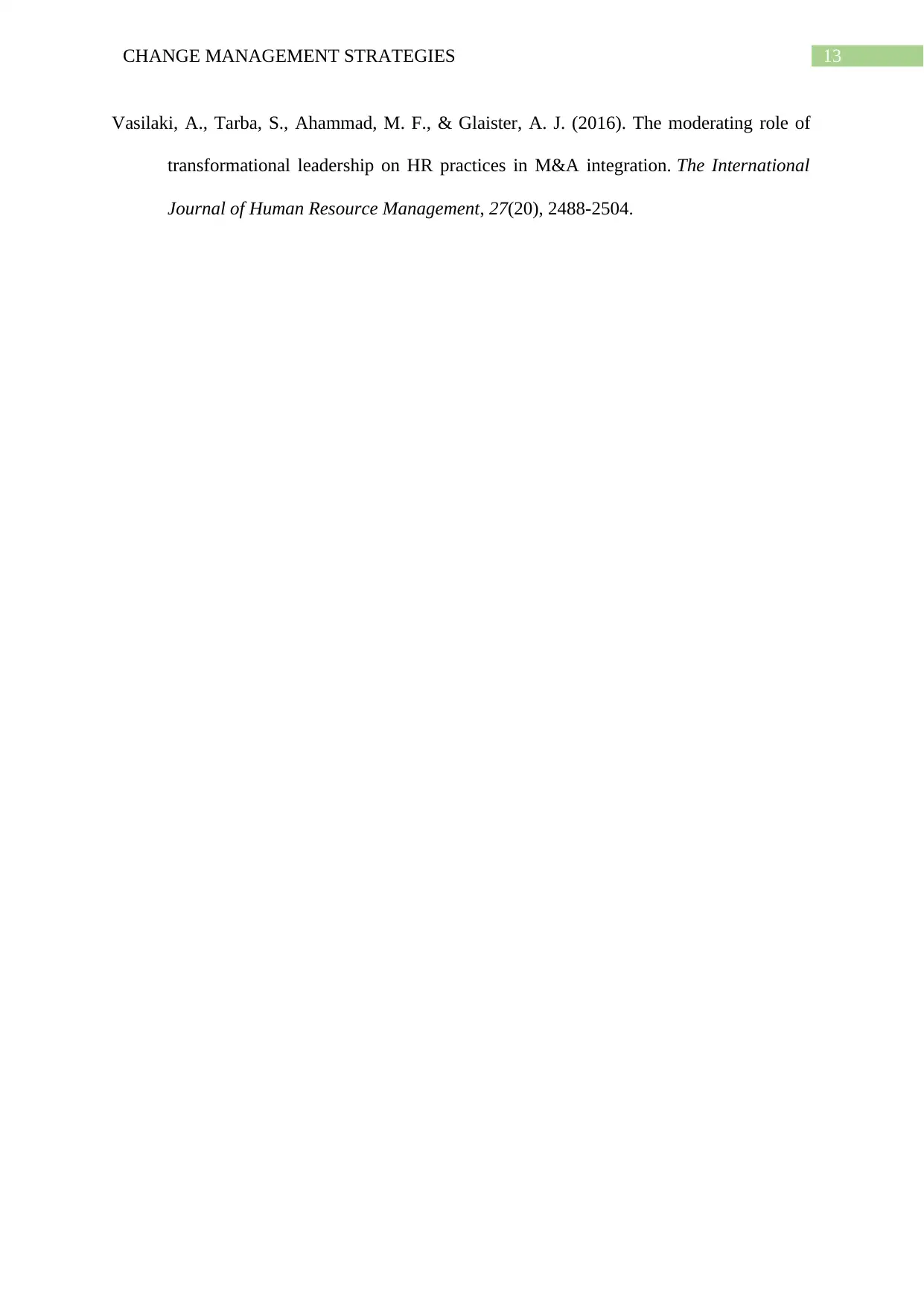
13CHANGE MANAGEMENT STRATEGIES
Vasilaki, A., Tarba, S., Ahammad, M. F., & Glaister, A. J. (2016). The moderating role of
transformational leadership on HR practices in M&A integration. The International
Journal of Human Resource Management, 27(20), 2488-2504.
Vasilaki, A., Tarba, S., Ahammad, M. F., & Glaister, A. J. (2016). The moderating role of
transformational leadership on HR practices in M&A integration. The International
Journal of Human Resource Management, 27(20), 2488-2504.
1 out of 14
Related Documents
Your All-in-One AI-Powered Toolkit for Academic Success.
+13062052269
info@desklib.com
Available 24*7 on WhatsApp / Email
![[object Object]](/_next/static/media/star-bottom.7253800d.svg)
Unlock your academic potential
© 2024 | Zucol Services PVT LTD | All rights reserved.





